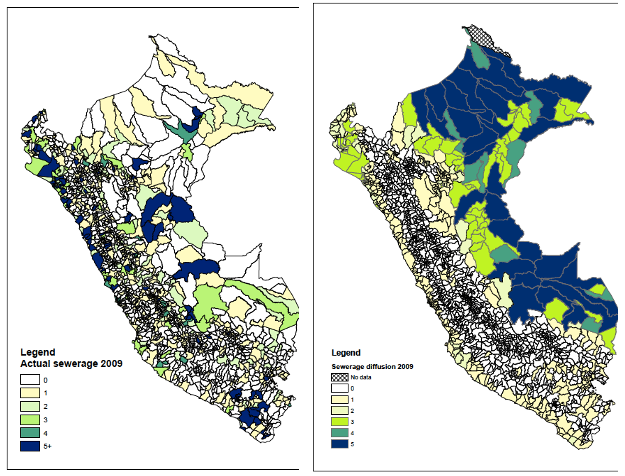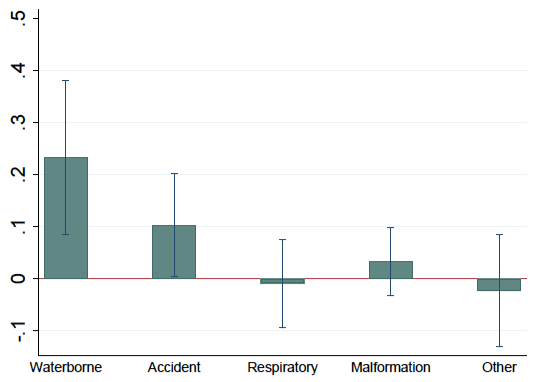
Incomplete and abandoned sewerage projects can increase risks of early life mortality and impose significant public health costs on populations
It has long been accepted that investing in infrastructure promotes economic growth and development (Aschauer 1989, Isham and Kaufmann 1999). Large amounts of resources are directed every year towards the development of water and sewerage, energy, transportation, and communication infrastructure. In 2019, the total spending in infrastructure projects in low- and middle-income countries (LMICs) amounted to around US$1.2 trillion (Fay et al. 2019). While debates continue to revolve around “how much” to spend, the key question of “how” to effectively deliver public infrastructure remains. Recent evidence suggests that over one-third of the public infrastructure projects started in LMICS are not completed (Rasul and Rogger 2018, Williams 2017).
Economic research has been very useful at identifying the effectiveness of infrastructure projects such as sewerage, dams, roads and electricity networks in promoting development once they are completed and in use (e.g Duflo and Pande 2007, Rud 2012, Lipscomb, Mobarak, and Barham 2013, Donaldson 2018). However, the consequences of unfinished projects that suffer from mid-construction abandonment – so-called ‘white elephants’ – are less clear. My research (Bancalari 2020) shows that such white elephants are more than a waste of public resources with high opportunity costs: they can kill.
Unfinished sewerage projects in Peru
I evaluate the effects of unfinished sewerage projects on the mortality of children under the age of five. This is an outcome that sewerage infrastructure has improved in advanced economies during the previous centuries (Watson 2006, Alsan and Goldin 2019). My research was motivated by reports of sewerage excavations leading to a rise in mosquito infestations and children drowning in stagnant water-filled ditches as deep as two meters (El Comercio 2018, Correo 2018).
The government of Peru invested US$ 3 billion to initiate more than 6,000 sewerage projects between 2005 and 2015. The diffusion of sewerage installation projects in Peru makes an excellent case study because of the national scale of this public intervention, which led to considerable spatial variation in implementation. The phased rollout of this implementation provides a good opportunity to evaluate the effects of infrastructure development on child mortality. To do this, I construct a district-level panel of 1,400 districts for each year between 2005 and 2015 by combining several sources of novel administrative data and spatial data at a grid cell level. Specifically, I rely on detailed project-level data on expense plans and expenditure timing to identify the number of projects completed or left unfinished in a given district.
I exploit the variation in unfinished projects generated by mid-construction abandonment and delays. A majority of these projects were ‘white elephants’ at some point: 80% of the projects started between 2005 and 2012 were abandoned for at least a year and up to the whole decade of the study. On the other hand, several of the newer projects are on the verge of becoming white elephants. I also find large variations in project duration (some of which lasted as long as eight years) associated with cost overruns.
Peru’s natural geographic variation lends itself to the instrumental variable utilised in this study. The instrument captures how the implementation of sewerage projects would have evolved had investments been based solely on cost considerations. I rely on the fact that a combination of geographic characteristics (i.e. land gradient, elevation and river density) affects a district's technical suitability for low-cost sewerage projects. A time-variant project implementation is predicted with an algorithmic approach, subject to a nationwide budget constraint and threshold of maximum projects implemented. In the counterfactual scenario, a central planner would have implemented more sewerage projects in cheaper districts, and would have done so earlier in the period of study.
The identification assumption is that no other factors affecting mortality rates change over time along the same spatial lines as the predicted implementation of projects. I control for time-invariant impacts of geography on health through district fixed effects, and annual shocks through year fixed effects. As a validity check, I find that my instrument has no effect on mortality before the start of projects and that it is not related to other types of infrastructure development, residential sorting or geography-specific mortality trends.
The maps below depict the actual (left) and predicted (right) implementation of projects in Peru, as a snapshot in 2009. The predicted allocation rollout provides variation across districts and years. The first-stage estimation proves the relevance of the instrument.
Figure 1 Actual and predicted implementation of sewerage projects in Peru in 2009

Unfinished Infrastructure can kill
I find that with every additional sewerage project launched, infant and under-five mortality increased by 6% over baseline averages. There are three mechanisms behind these non-trivial effects..
- The installation of sewerage lines results in water cuts, and I find deteriorations in water and sanitation practices in line with this expectation.
- These projects also require extensive excavations, which leave open ditches that can fill up with stagnant water and become breeding grounds for infection-carrying vectors.
- Such large building sites can pose hazards to the population by, for instance, diverting traffic chaotically into quiet residential areas where children roam freely.
In line with these mechanisms, I find that every additional unfinished project increased infant and under-five mortality due to water-borne diseases, and under-five mortality due to accidents. Notably, I find no effects of unfinished projects on the mortality caused by other diseases and complications unrelated to infections or external hazards.
Figure 2 Effect of an additional unfinished sewerage project on under-five mortality (by cause of death)

What happens once projects are completed?
To get a full picture of project implementation and to better understand the counterfactual scenario, I also estimate the effect of completed projects. As an additional instrument, I use the interaction between a district's geographical suitability for low-cost sewerage projects and the partisan alignment between the district mayor and central government. Mayors politically connected to the parliament complete more projects, conditional on starting them because of the district's geographic suitability for low-cost sewerage projects.
I find that early-life mortality increased with unfinished projects and decreased with completed projects, compared with no projects started. The estimated effect of unfinished infrastructure on mortality remains robust even after including project completion. Furthermore, infant and under-five mortality decreased with every additional completed project by 33% and 25% over the initial averages respectively, in line with historical studies (Alsan and Goldin 2019).
How can we stop ‘white elephants’ and prevent social costs?
By the end of this study in 2015, 35% of the projects were still abandoned with an average of 40% of the contractual sum disbursed. If these projects are never completed, rough calculations suggest that they will generate a waste equal to one third of the public expenditure on tertiary education in 2015 in Peru (World Bank 2020). These figures reflect the high social opportunity cost of the non-completion of public infrastructure.
While the wasteful government expenditure on abandoned projects is worrisome, it is even more disconcerting that this inefficiency kills children. However, there are relatively simple steps that may help reduce this problem. Stricter health and safety measures, improvements in the quality of primary health care, and the provision of alternative safe sources of water and sanitation can help prevent child deaths during the construction phase.
Existing literature points to policy alternatives to attain project completion, but there is room to explore further. Rasul and Rogger (2018) suggest that managerial practices of local bureaucrats such as incentive schemes increase the probability of completing infrastructure projects. Williams (2017) suggests the inclusion of inter-governmental rules for completing a project before starting a new one as a way to deal with unstable local political dynamics that deter project completion.
Finally, for the social benefits of completed public infrastructure to fully manifest, governments need to run the `last mile’ – i.e. connect the infrastructure to final users. Ashraf, Glaeser, and Ponzetto (2016) suggest finding a ‘sweet spot’ between fines and subsidies to promote universal connectivity to public sewers. Galiani, Gertler, and Schargrodsky (2005) find large gains in connectivity and performance linked to the privatisation of sewerage services in Argentina, which ultimately decreased child mortality.
Editors’ note: A version of this column first appeared on World Bank Blogs – Development Impact.
References
Alsan, M and C Goldin (2019), "Watersheds in Child Mortality: The Role of Effective Water and Sewerage Infrastructure, 1880 to 1920", Journal of Political Economy 127(2): 586–638.
Aschauer, D A (1989), "Is Public Expenditure Productive?", Journal of Monetary Economics 23: 177–200.
Ashraf, N, EL Glaeser and GAM Ponzetto (2016), "Infrastructure, Incentives, and Institutions", American Economic Review: Papers & Proceedings 106(5): 77–82.
Bancalari, A (2020), "Can White Elephants Kill? Unintended Consequences of Infrastructure Development in Peru", The IFS WP 20/32.
El Comercio, E (17 February 2018), "Criadero de Zancudos En Asia Por Obra Paralizada".
Correo (9 February 2018), "Children Drown in an Open Ditch from Sewerage Project".
Donaldson, D (2018), "Railroads of the Raj: Estimating the Impact of Transportation Infrastructure", American Economic Review 108 (5): 899–934.
Duflo, E and R Pande (2007), "Dams", The Quarterly Journal of Economics 122 (2): 601–46.
Fay, M, HI Lee, M Mastruzzi, S Han and M Cho (2019), "Hitting the Trillion Mark A Look at How Much Countries Are Spending on Infrastructure", World Bank.
Galiani, S, P Gertler and E Schargrodsky (2005), "Water for Life: The Impact of the Privatization of Water Services on Child Mortality", Journal of Political Economy 113 (1): 83–120.
Isham, J and D Kaufmann (1999), "The Forgotten Rationale for Policy Reform: The Productivity of Investment Projects", The Quarterly Journal of Economics 114 (1): 149–84.
Lipscomb, M, AM Mobarak and T Barham (2013), "Development Effects of Electrification: Evidence from the Topographic Placement of Hydropower Plants in Brazil", American Economic Journal: Applied Economics 5 (2): 200–231..
Rasul, I and D Rogger (2018), "Management of Bureaucrats and Public Service Delivery: Evidence from the Nigerian Civil Service", The Economic Journal 128 (608): 413–46.
Rud, JP (2012), "Electricity Provision and Industrial Development: Evidence from India", Journal of Development Economics 97: 352–67.
Watson, T (2006), "Public Health Investments and the Infant Mortality Gap: Evidence from Federal Sanitation Interventions on U.S. Indian Reservations", Journal of Public Economics 90 (8): 1537–60.
Williams, MJ (2017) "The Political Economy of Unfinished Development Projects: Corruption, Clientelism, or Collective Choice?", American Political Science Review 111(4): 705–723.
World Bank (2020), "World Development Indicators".

